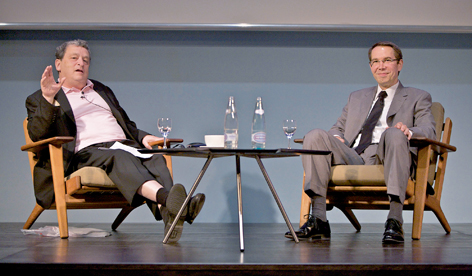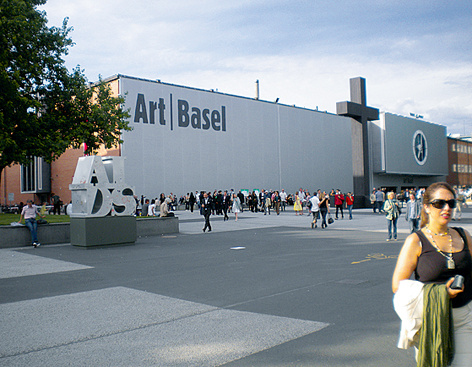|
|
| Art 40 Basel - a maniferstation of market confidence Marita Batņa, culture theorist 10.06.-14.06.2009. Basel | |
 Norman Rosenthal (from the left) and Jeff Koons at Art 40 Basel Conversations. Photo: Art Basel | |
| Signs of regained market stability, buyers wishing to indulge despite the crisis, and the Venice Biennale which was taking place in parallel were the factors encouraging a healthy environment at the Swiss town of Basel for a yet another triumphant show of the world's most powerful contemporary art galleries, Art Basel, which was offering an enhanced 40th anniversary programme. Clients and art professionals from across the world flocked to Art 40 Basel on 9 June for the pleasure of getting together, sourcing information and establishing contacts, and the trading in art works was surprisingly brisk. The fair was open to the public from 10 to 14 June. The core line-up of Art 40 Basel consisted of 241 galleries - 80% of these associated with the "Great Six": USA, Germany, Switzerland, UK, France and Italy, and only 20% representing 22 other countries. | |
 Art 40 Basel. Hall 2. Photo: Marita Batņa | |
| The ground floor of the exhibition space was oriented to the elitist market with the presence of powerful galleries such as Landau, Gmurzynska, Helly Nahmad, Krugier, Gray, Marlborough, Gagosian, Acquavella. Each gallery sought to entice buyers with quality, showing masters of modernism along with celebrated post-war and living artists. Many placed bets on the artists represented at the Venice Biennale. Prices were roughly at the same level as around two years ago. An air of excitement surrounded the Hauser&Wirth gallery: priced at 1.5 million US dollars, the silvery Piggy Stainless Steel (2008) by Paul McCarthy (born 1945) was a reminder that his large and expressive mixed media sculptures are available at the gallery's space in Zurich. Hauser&Wirth sold two (of a total of three) Piggies, along with works by Louise Bourgeois and Subodh Gupta. A deal by the New York gallerist David Zwirner became the hot news of the fair. Two elite buyers, Brad Pitt and Eli Broad, had considered Etappe (1998) by Leipzig artist Neo Rauch (b. 1960), a painting reflecting motifs of a F1 race. The experienced art collector gave way to the film star, who bought the work for almost 1 million dollars. Bischofberger (Zurich) attracted attention by offering only one, nevertheless very impressive work - the 11metre wide Big Retrospective Painting (1979) by Andy Warhol, for an asking price of 80 million Swiss francs (74 million US dollars). Potential buyer Roman Abramovich was seen to inspect the pavilion several times; however, as at the close of the fair, a sale had not been confirmed. More recently created art was presented on the upper level. Here the most characteristic features were a vast choice of authors, a regional context, and more moderate prices. Reckless buying was left to the past, however the opportunity for acquiring strong and captivating works in a variety of media (painting, photography, mixed media, sculpture, installation, video, kinetic art, objects) was taken. Tony Oursler's (b.1957) video-sculpture with a church pew (2009) sold for 100,000 euro at Lorenzo (Madrid). The Helsinki gallery Anhava boasted a large work by the Norwegian artist Anne-Karin Furunes (b.1961) - a photographic portrait on a finely perforated canvas. While this was available for 38,000 euro, other smaller works in the series were sold. The finer quality of the galleries Foksal (Warsaw) and Podnar (Ljubljana, Berlin) stood out in the general context. The latter, in its small exposition, had included a black-and-white video work by the Swedish artist Alexander Gutke (b. 1971) for 4000 euro, which harmonised well with two installations by the Hungarian artist Attila Csörgő (b. 1965), each costing 13,000 euro. The gallery's representative was satisfied: even though demand was not as strong as last year, a number of works had found buyers. It should be noted that the native Latvian artist Vija Celmiņš (b. 1939) was also represented in this world-class show, by the galleries McKee and Gemini from the USA. | |
 Tony Oursler. Untitled. Church Pew. Lorenzo. Photo: Marita Batņa | |
| The sections Art Premiere and Art Statements provide for the Art Basel organisers a way to influence a show, focussing on curatorial practice and giving prominence to young artists and galleries. Art Premiere included 19 galleries with projects by two-artist tandems, meanwhile 27 more galleries took part with solo shows within Art Statements. Engendering tough competition, these programmes mean that Art Basel's doors are open to strong emerging galleries. Hopefully, the most determined ones from the Baltic States will also appear at some point in the future. As always, clients were attracted by the smaller shows offering new art, however, the number of these had decreased. Liste, regarded as the "child" of Art Basel, discovers new galleries through curated shows: this year Tulips & Roses from Vilnius featured for the first time. The Gallery Bastejs (Riga) took part in Scope, which, combined with Art Asia, was located at a short walking distance from Art Basel, and this proved to have positive impact on results. Volta found space at the former vegetable market pavilion. Here, the Spencer Brownstone gallery from New York sold three (of six) installations Flux (2009) by Lithuanian artist Žilvinas Kempinas (b. 1969), for 35,000 euro each. Art Basel stands for the principle of linking the art market with contemporary art development, unlimited in its means of expression. This aspiration is traditionally served by the sections Art Unlimited and Public Art Projects, where this year 77 galleries took part with large-scale projects. In addition, special attention was paid to performance art, including a discussion on collecting it and, of course, the anniversary gift at the Theatre Basel - Il Tempo del Postino ("Postman Time"). Curators Hans Ulrich Obrist and Philippe Parreno presented a group show of 17 works by well-known artists, who were given "time" as the main rule of the game. The show maintained coherence and the tactics in the succession of works elicited surprise, relaxation and emotion, among other impulses. In the course of this unconventional visual art journey (as spectators were absorbing the activity around the stage, in their seats or walking around) the art market was allowed to become personified and gain inspiration. Doug Aitken played out the rules with the language of the market - as commodities traders simulated an auction with high skill. Altogether, Il Tempo had an effect on the level of market confidence; the Basel show was an augmented and modified version of the first presentation in Manchester in 2007. Another event supplying "what was needed", in keeping with the mood at this particular historic moment, was the chat of Sir Norman Rosenthal, former exhibitions secretary of the London Royal Academy of Arts, with the auction record-breaker Jeff Koons. "The highest state of art is acceptance, and self-acceptance is the first thing. Art is like a vocabulary, it gives empowerment, a way to understand the world", said the charming and perfectly-dressed Koons, refining the ideals of Western culture and hence his formula for success. Gallerists at Art 40 Basel unanimously agreed that sales were solid, which led media representatives to wonder whether the crisis was already over. However one of the discussions, referring to conditions in 90s, put the question another way: "How and why is this art market contraction different?" The answer was given by the art advisor Allan Schwartzman (New York): "The art market is having much broader support because of new buyers; the overall learning curve has significantly gone up". Considering that some buyers, gallerists and dealers have moved away from the field of art, Art 40 Basel demonstrated that the "real" art market, by its sheer volume and strength, is not likely to experience a crash. | |
| go back | |







